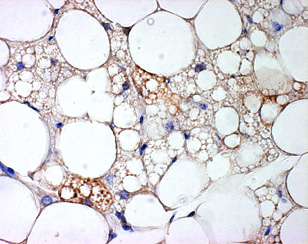The Colour Of Fat
Wednesday, May 7, 2014As a regular reader you will be well aware that body fat is not body fat. Much depends on its exact location, but also on the cellular structure and biological function of the different types of fat depots.
This is the subject of a paper by Brian Owens, a science editor from New Brunswick, Canada, published in the recent Nature Outlook supplement on Obesity.
Although, the predominant form of fat tissue in humans is white fat (which, is in fact yellow), we also have other types of fat cells that are either brown or beige.
While the primary function of white fat cells is to store fat, brown(ish) fat cells specialize in burning it.
This may lead us to believe that brown fat cells are the “good guys” whereas white fat cells are the “bad guys” but this could not be further from the truth.
As Owens explains (quoting Patrick Seale), the white fat cells actually play a key role in keeping us safe from the ill-effects of excess fat by safely sequestering it away:
“Healthy white fat protects the body by providing a ‘safe home’ for lipids, which can be toxic to other tissues such as muscle or the liver. So these fat cells hold on to the lipids until the energy they are storing is needed, when they release them into the blood.”
Thus, white fat actually plays an important role in protecting us from metabolic disease. This is most evident in people who genetically (or in the case of anti-retroviral treatment) lack sufficient white fat cells. These folks end up depositing their excess fat in those other tissues (e.g. liver, pancreas, muscle, etc), thereby causing exactly the same metabolic problems that are commonly associated with obesity.
So why do some people with excess white fat develop these problems?
Here Owens quotes Philipp Scherer, who explains that cell size may have something to do with this:
“Problems arise when white fat cells store too much lipid. They begin expanding and proliferating rapidly in a process that resembles the growth of a solid tumour….The blood supply cannot keep up with this expansion, and the cells begin to suffer from lack of oxygen. This hypoxia attracts the protein HIF-1α, which in fat tissue stimulates the extracellular matrix surrounding the cells, leading to fibrosis. The huge, oxygen-starved fat cells do not have enough room to expand and get squeezed to death, releasing their lipid cargo. As the cells start to die, macrophages swarm to the fat depots to try and clean up the mess by carrying away the lipid droplets. The problem is that the macrophages cannot clear up the lipids fast enough, and so they begin to spill over into other tissues, such as the liver and pancreas.”
As for brown fat – it has a completely different function, namely to help regulate body temperature by burning off calories to generate heat.
But researchers have discovered yet an additional type of fat cell – one that lies some where between typical white and brown fat. In fact, it seems that most the brown fat in humans is actually beige – these seem to be cells recruited from white fat depots that transform themselves into “brownish” cells with certain stimuli (e.g. cold exposure, physical exercise).
These beige cells may also be important protectors against metabolic disease. The article quotes work by Bruce Spiegelman showing that selectively disabling beige fat in mice by targeting the protein PRDM16, which is found only in these cells, leaving the white and brown fat intact leads to animals with severe metabolic dysfunction — obesity, insulin resistance and fatty livers.
Thus it appears that the loss of the beige fat destroys the protective abilities of subcutaneous white fat – at least in mice.
If nothing else, these studies show that we have yet much to learn about fat cells. In fact, there may be other subtypes of fat cells specific to the different fat depots in the body (of which there are many), that may each have their unique importance and functions.
Whether or not we can harness this new knowledge to find better treatments for obesity remains to be seen – simply destroying fat cells willy-nilly can certainly do more harm than good.
@DrSharma
New York, NY



